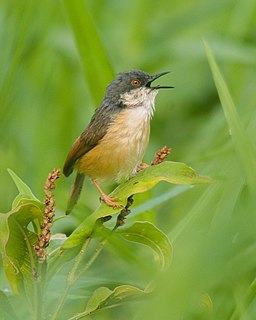
The ashy prinia or ashy wren-warbler is a small warbler in the family Cisticolidae. This prinia is a resident breeder in the Indian Subcontinent, ranging across most of India, Nepal, Bangladesh, eastern Pakistan, Bhutan, Sri Lanka and western Myanmar. It is a common bird in urban gardens and farmland in many parts of India and its small size, distinctive colours and upright tail make it easy to identify. The northern populations have a rufous rump and back and have a distinct breeding and non-breeding plumage while other populations lack such variation.
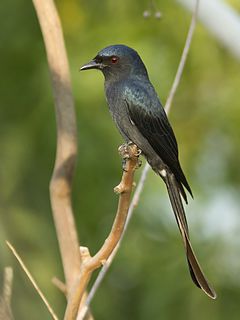
The ashy drongo is a species of bird in the drongo family Dicruridae. It is found widely distributed across South and Southeast Asia with several populations that vary in the shade of grey, migration patterns and in the size or presence of white patches around the eye.

The ashy flycatcher is a species of bird in the Old World flycatcher family Muscicapidae. It is found throughout sub-Saharan Africa, excluding the drier areas of South Africa, Botswana, and Namibia, where it inhabits subtropical or tropical dry forest, subtropical or tropical moist lowland forest, and savanna. It has a disputed generic placement, with different authorities variously putting it in Muscicapa, Fraseria, or other genera. The species does not display sexual dimorphism, with both sexes being grey in colour with pale grey or white underparts.
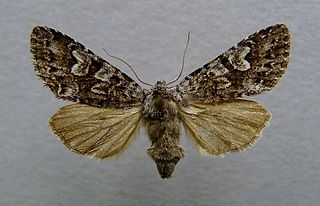
Papestra biren, the glaucous shears, is a moth of the family Noctuidae. The species was first described by Johann August Ephraim Goeze in 1781. It is found in most of Europe, but not in the southern parts of the Iberian Peninsula, Italy and Greece. Outside of Europe it is found in Kashmir and through the Palearctic to Siberia, Central Asia, Amur, Kamchatka, the Russian Far East and Japan. It was introduced in Newfoundland in 1935 and has since then extended its range ever more southward within North America partly overlapping with Papestra quadrata(Smith, 1891). It rises to 2200 m above sea level in the Alps.
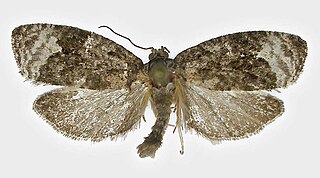
Apotomis capreana is a moth of the family Tortricidae. It is found in most of Europe, east to the eastern part of the Palearctic realm.

Nycteola revayana, the oak nycteoline, is a moth of the family Nolidae. The species was first described by Giovanni Antonio Scopoli in 1772. It is found from Europe and east across the Palearctic to Japan and India.
Stenoptilia coloradensis is a moth of the family Pterophoridae. It is found in North America.
Stenoptilia mengeli is a moth of the family Pterophoridae. It is found in Greenland and Nunavut, Canada.
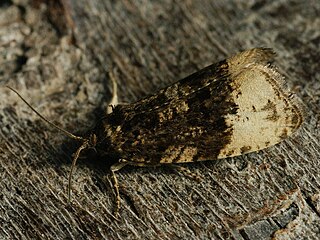
Hedya ochroleucana, the buff-tipped marble or long-cloaked marble, is a moth of the family Tortricidae. It is found in most of Europe, except part of the Balkan Peninsula and Ukraine and east across the Palearctic. It is also present in most of North America.
Dichomeris analoxa is a moth in the family Gelechiidae. It was described by Edward Meyrick in 1911. It is found in South Africa.
Dichomeris melitura is a moth in the family Gelechiidae. It was described by Edward Meyrick in 1916. It is found in southern India.

Ardozyga nyctias is a species of moth in the family Gelechiidae. It was described by Edward Meyrick in 1904. It is found in Australia, where it has been recorded from southern Queensland and New South Wales.
Locharcha is a genus of moths in the family Gelechiidae. It contains the species Locharcha emicans, which is found in Peru.
Thiotricha janitrix is a moth of the family Gelechiidae. It was described by Edward Meyrick in 1912. It is found in the Bengal region of what was British India.
Stenoma melanesia is a moth of the family Depressariidae. It is found in Colombia.
Stenoma nebrita is a moth of the family Depressariidae. It is found in Panama, Costa Rica and Guyana.
Antaeotricha tephrodesma is a moth of the family Depressariidae. It is found in Brazil and the Guianas.
Xylorycta melanula is a moth in the family Xyloryctidae. It was described by Edward Meyrick in 1890. It is found in Australia, where it has been recorded from New South Wales.
Enchocrates phaedryntis is a moth in the family Depressariidae. It was described by Edward Meyrick in 1888. It is found in Australia, where it has been recorded from Western Australia.
Filinota lamprocosma is a moth in the family Depressariidae. It was described by Edward Meyrick in 1916. It is found in French Guiana.







